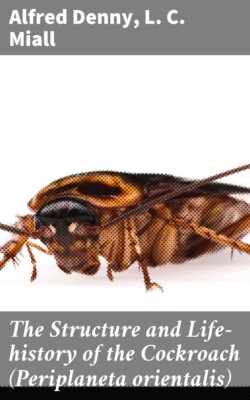Читать книгу The Structure and Life-history of the Cockroach (Periplaneta orientalis) - L. C. Miall - Страница 12
Characters of Insects.
ОглавлениеInsects are distinguished from other Arthropoda by the arrangement of the segments of the body into three plainly marked regions—head, thorax, and abdomen; by the three pairs of ambulatory legs carried upon the thorax; by the single pair of antennæ; and by the tracheal respiration. Myriopods and Arachnida have no distinct thorax. Most Crustacea have two pairs of antennæ, while in Arachnida antennæ are wanting altogether. Crustacea, if they possess special respiratory organs at all, have branchiæ (gills) in place of tracheæ (air-tubes). In Arachnida, Myriopoda, and Crustacea there are usually more than three pairs of ambulatory legs in the adult.
The appendages of an Insect’s head (antennæ, mandibles, maxillæ) are appropriated to special senses, or to the operations of feeding, and have lost that obvious correspondence with walking legs which they still retain in some lower Arthropoda (Peripatus, Limulus, Arachnida). The thorax consists of three8 segments, each of which carries a pair of ambulatory legs. No abdominal legs are found in any adult insect. The middle thoracic segment may carry a pair of wings or wing-covers, and the third segment a pair of wings.
The lower or less-specialised Insects, such as the Cockroach, have nearly as many nerve-ganglia as segments, and the longitudinal connectives of the nerve-cord are double. In the adult of certain higher Insects9 (e.g., many Coleoptera, and some Diptera) the nerve-ganglia are concentrated, reduced in number, and restricted to the head and thorax; while all the connectives, except those of the œsophageal ring, may be outwardly single.
The heart, or dorsal vessel, is subdivided by constrictions into a series of chambers, from which an aorta passes forwards to the head.
Air is usually taken into the body by stigmata or breathing-pores,10 which lie along the sides of the thorax and abdomen. It circulates through repeatedly-branching tracheal tubes, whose lining is strengthened by a spiral coil. Air-sacs (dilated portions of the air-tubes) occur in Insects of powerful flight.
The generative organs are placed near the hinder end of the body.11 Most Insects are oviparous.12 The sexes are always distinct; but imperfect females (“neuters”) occur in some kinds of social Insects. Agamogenesis (reproduction by unfertilised eggs) is not uncommon.
